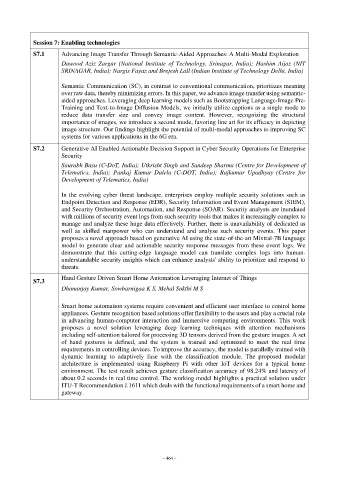Page 508 - Kaleidoscope Academic Conference Proceedings 2024
P. 508
Session 7: Enabling technologies
S7.1 Advancing Image Transfer Through Semantic-Aided Approaches: A Multi-Modal Exploration
Dawood Aziz Zargar (National Institute of Technology, Srinagar, India); Hashim Aijaz (NIT
SRINAGAR, India); Nargis Fayaz and Brejesh Lall (Indian Institute of Technology Delhi, India)
Semantic Communication (SC), in contrast to conventional communication, prioritizes meaning
over raw data, thereby minimizing errors. In this paper, we advance image transfer using semantic-
aided approaches. Leveraging deep learning models such as Bootstrapping Language-Image Pre-
Training and Text-to-Image Diffusion Models, we initially utilize captions as a single mode to
reduce data transfer size and convey image content. However, recognizing the structural
importance of images, we introduce a second mode, favoring line art for its efficacy in depicting
image structure. Our findings highlight the potential of multi-modal approaches to improving SC
systems for various applications in the 6G era.
S7.2 Generative AI Enabled Actionable Decision Support in Cyber Security Operations for Enterprise
Security
Saurabh Basu (C-DoT, India); Utkrisht Singh and Sandeep Sharma (Centre for Development of
Telematics, India); Pankaj Kumar Dalela (C-DOT, India); Rajkumar Upadhyay (Centre for
Development of Telematics, India)
In the evolving cyber threat landscape, enterprises employ multiple security solutions such as
Endpoint Detection and Response (EDR), Security Information and Event Management (SIEM),
and Security Orchestration, Automation, and Response (SOAR). Security analysts are inundated
with millions of security event logs from such security tools that makes it increasingly complex to
manage and analyze these huge data effectively. Further, there is unavailability of dedicated as
well as skilled manpower who can understand and analyse such security events. This paper
proposes a novel approach based on generative AI using the state-of-the-art Mixtral-7B language
model to generate clear and actionable security response messages from these event logs. We
demonstrate that this cutting-edge language model can translate complex logs into human-
understandable security insights which can enhance analysts' ability to prioritize and respond to
threats.
Hand Gesture Driven Smart Home Automation Leveraging Internet of Things
S7.3
Dhananjay Kumar, Sowbarnigaa K S, Mehal Sakthi M S
Smart home automation systems require convenient and efficient user interface to control home
appliances. Gesture recognition based solutions offer flexibility to the users and play a crucial role
in advancing human-computer interaction and immersive computing environments. This work
proposes a novel solution leveraging deep learning techniques with attention mechanisms
including self-attention tailored for processing 3D tensors derived from the gesture images. A set
of hand gestures is defined, and the system is trained and optimized to meet the real time
requirements in controlling devices. To improve the accuracy, the model is parallelly trained with
dynamic learning to adaptively fuse with the classification module. The proposed modular
architecture is implemented using Raspberry Pi with other IoT devices for a typical home
environment. The test result achieves gesture classification accuracy of 98.24% and latency of
about 0.2 seconds in real time control. The working model highlights a practical solution under
ITU-T Recommendation J.1611 which deals with the functional requirements of a smart home and
gateway.
– 464 –

